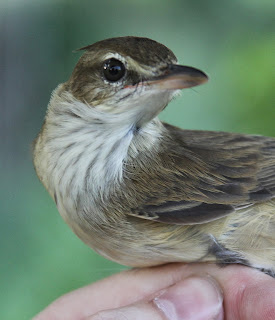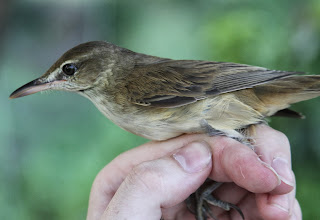A very interesting afternoon spent ringing with Richard on the farms. The initial catch (2pm - 4pm) was exclusively Chestnut Munias, but as the light faded we started to get a few different things, including several Acrocephalus warblers, which presented more of an identification challenge than I expected. Certainly some were Oriental Reed Warblers, and some of the smaller birds could only have been the resident harterti race of Clamorous Reed Warbler, however there were a couple which I am still unsure about. I think we shall revisit the area soon, and try to get a bit more experience at identifying these tricky birds.
While ringing Richard spotted the calidus Peregrine had arrived, the first sighting this winter.
Several large Acrocephalus warblers were trapped towards the end of the day, and presented more of an identification challenge than I had anticipated. This first bird showed clear streaking on the breast...
... quite striking at certain angles, and had measurements (weight, length, wing length) that exceeded the (presumably median) values given in Kennedy for Oriental Reed Warbler. Overall the harterti race of Clamorous Reed Warbler we get on Luzon is said to be smaller than other races.
With little biometric data to refer to it is hard to make definitive identifications based on measurements alone. The plumage tones of this bird are interesting, it appears to be a 'colder' brown than the next one we caught...
The second of several Acros. One of the features said to separate Oriental from Clamorous is the latter's relatively finer bill, and less distinct supercilium. Based on that alone I see little distinction between the two birds....
...though the plumage of the second has a 'warmer' tone...
...both species show pale buffy tips to the tail feathers...
...but the second bird has clearly emarginated primaries, most notably P3 and P4. Is P5 emarginated or just slightly bent? If it was it would rule out Oriental. Phil Round points out that as orientalis moults on its breeding grounds this has to be the resident harterti anyway!
At some angles the second bird had clear throat streaking. Apparently some juvenile Clamorous Reed Warblers show some breast streaking, it doesn't seem to be the clinching feature I imagined it to be...
Less difficult to identify, we caught lots of Chestnut Munias, including this immature ...
...this one is approaching adult plumage...
... and several adults.











re. reed warblers in the hand: harterti p2 < p5 (usually = p7/p8) orientalis p2 usually > p5 (rarely slightly shorter, p5/p6). Your moulting bird has to have been harterti since orientalis moults on breeding grounds. Harterti is shorter winged, smaller and shorter billed then orientalis (contra other Clamorous races). (And, in my experience, harterti is a good deal commoner than orientalis in "trash" habitats. I only found orientalis in the better quality sites in central Luzon, though of course in the migration season I guess it could turn up anywhere. I can send you biometrics of orientalis and harterti if you want. Philip Round
ReplyDelete